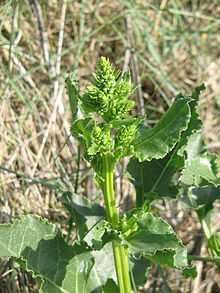Sea beet
| Sea Beet | |
|---|---|
 | |
| Scientific classification | |
| Kingdom: | Plantae |
| (unranked): | Angiosperms |
| (unranked): | Eudicots |
| (unranked): | Core eudicots |
| Order: | Caryophyllales |
| Family: | Amaranthaceae |
| Genus: | Beta |
| Species: | B. vulgaris |
| Subspecies: | B. vulgaris subsp. maritima |
| Trinomial name | |
| Beta vulgaris subsp. maritima (L.) Arcang. | |
The sea beet, Beta vulgaris subsp. maritima ((L.) Arcangeli.[1]), is a member of the family Amaranthaceae, previously of the Chenopodiaceae. Carl Linnaeus first described Beta vulgaris in 1753; in the second edition of Species Plantarum in 1762 he divided the species into wild and cultivated varieties, giving the name Beta maritima to the wild taxon.[2]
The sea beet is native to the coasts of Europe, northern Africa, and southern Asia. It also lives in the wild along some shores in Great Britain.
The sea beet is the wild ancestor of common vegetables such as beetroot, sugar beet, and Swiss chard. [3] Its leaves have a pleasant texture and taste when served raw or cooked, and because of this it is also known as wild spinach.
It is a perennial plant which grows up to 1.2 m, and flowers in the summer. Its flowers are hermaphroditic, and wind-pollinated. It requires moist, well-drained soils, and does not tolerate shade. However, it is able to tolerate relatively high levels of sodium in its environment.
References
- ↑ Lange, W., W. A. Brandenburg and T.S.M. De Bock. 1999. Taxonomy and cultonomy of beet (Beta vulgaris L.). Botanical J. of the Linnean Society 130:81-96.
- ↑ Lange, W. (1996). "International Beta Genetic Resources Network". Bioversity International. p. 24. Retrieved 9 July 2011. "In the second edition of Species Plantarum (1762), the species was split up into wild and cultivated materials. The wild taxon was named Beta maritima, and the cultivated material remained to be split up into varieties carrying Latin names."
- ↑ Beta Maritima: The Origin of Beets. Springer. 2012. ISBN 978-1-4614-0841-3. "The volume will be completely devoted to the sea beet, that is, the ancestor of all the cultivated beets. The wild plant, growing mainly on the shore of the Mediterranean Sea, remains very important as source of useful traits for beet breeding."
External links
| Wikimedia Commons has media related to Sea beet. |